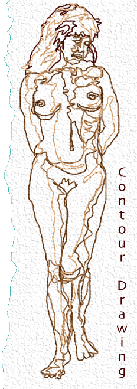 Primer |
Contour and Blind Contour DrawingAn excellent starting point to improve your drawing skills and prepare for drawing the figure is through contour drawing and blind contour drawing. Contour drawing is a process of line drawing where one must concentrate on a single point and follow the contours of the body. This process should be done in one long continuous line to mimic the way that the eye works. When doing a contour drawing, you are improving your eye-hand coordination, an important skill in both art and athletics. Blind Contour Drawing: Blind contour drawing infers that one is not looking at the figure. In fact, the process of blind contour drawing is just the opposite. You must look only at the figure and "feel" your way across the paper. This takes quite a bit of practice because we have been taught to constantly look at the paper as we draw. This was an effective "warm-up" tool for Leonardo da Vinci and other Renaissance artists. Use a pencil and a simple object (like a pear) and follow the process written below.
A good example of contour drawing can be seen in the drawing of Dr. Ernst Wagner, by Egon Schiele done in 1918. A good book to help your observation skills is Betty Edwards' Drawing On the Right Side of the Brain. It has some excellent exercises for honing your observation skills and improving your eye-hand coordination.
Questions or comments can be forwarded to Ralph Larmann at the University of Evansville. |  The image above is a contour drawing of a female model. Each line is one long continuous line of differing colors which help to define the form. It was done as an exercise to get the eye and hand to work together.  
|

| [Primer] created 6/15/98 by R. M. Larmann |

Custom Search
|